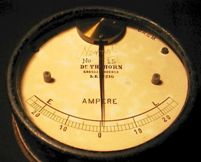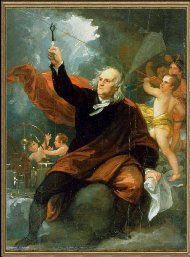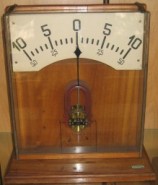Categories: Featured Articles » Interesting Facts
Number of views: 64405
Comments on the article: 4
The history of a paradox of electrical engineering
 If you compose an electric circuit from a current source, an energy consumer and the wires connecting them, close it, then an electric current will flow along this circuit. It is reasonable to ask: “And in what direction?” The textbook on the theoretical foundations of electrical engineering gives the answer: “In the external circuit, current flows from the plus of the energy source to minus, and in the inside of the source from minus to plus” (1).
If you compose an electric circuit from a current source, an energy consumer and the wires connecting them, close it, then an electric current will flow along this circuit. It is reasonable to ask: “And in what direction?” The textbook on the theoretical foundations of electrical engineering gives the answer: “In the external circuit, current flows from the plus of the energy source to minus, and in the inside of the source from minus to plus” (1).
Is it so? Recall that an electric current is the ordered movement of electrically charged particles. Those in metal conductors are negatively charged particles - electrons. But the electrons in the external circuit move just the opposite from the minus of the source to the plus. This can be proved very simply. It is enough to put an electronic lamp - a diode in the above circuit. If the anode of the lamp is positively charged, then the current in the circuit will be, if it is negative, then there will be no current. Recall that opposite charges attract, and like charges repel. Therefore, the positive anode attracts negative electrons, but not vice versa. We conclude that the direction opposite to the motion of electrons is taken as the direction of electric current in the science of electrical engineering. (2)
The choice of the direction opposite to the existing one cannot be called otherwise paradoxical, but the reasons for such a discrepancy can be explained if we trace the history of the development of electrical engineering as a science.
Among the many theories, sometimes even anecdotal, trying to explain the electrical phenomena that appeared at the dawn of the science of electricity, let us dwell on two main ones.
 The American scientist B. Franklin put forward the so-called unitary theory of electricity, according to which electric matter is a kind of weightless liquid that could leak out of some bodies and accumulate in others. According to Franklin, an electric fluid is contained in all bodies, and becomes electrified only when there is a lack or excess of electric fluid in them. A lack of fluid means negative electrification; an excess means positive. So the concept of positive and negative charge appeared. (3) When positively charged bodies are connected with negative bodies, an electric fluid (fluid) passes from a body with an increased amount of liquid to bodies with a reduced amount. As in communicating vessels. With the same hypothesis, the concept of the movement of electric charges - electric current - entered into science. (4)
The American scientist B. Franklin put forward the so-called unitary theory of electricity, according to which electric matter is a kind of weightless liquid that could leak out of some bodies and accumulate in others. According to Franklin, an electric fluid is contained in all bodies, and becomes electrified only when there is a lack or excess of electric fluid in them. A lack of fluid means negative electrification; an excess means positive. So the concept of positive and negative charge appeared. (3) When positively charged bodies are connected with negative bodies, an electric fluid (fluid) passes from a body with an increased amount of liquid to bodies with a reduced amount. As in communicating vessels. With the same hypothesis, the concept of the movement of electric charges - electric current - entered into science. (4)
Franklin's hypothesis proved to be highly fruitful and anticipated the electronic theory of conduction.However, it turned out to be far from perfect. The fact is that the French scientist Dufe discovered that there are two types of electricity, which, obeying each individually Franklin theory, neutralized each other upon contact. (5). The reason for the emergence of a new dualistic theory of electricity, put forward by Simmer on the basis of Dufe's experiments, was simple. Surprisingly, over the course of many decades of experiments with electricity, no one noticed that when rubbing electrified bodies, not only the rubbed, but also the rubbing body is charged. Otherwise, the Simmer hypothesis would simply not have appeared. But the fact that she appeared has her own historical justice. (6)
The dualistic theory believed that in the bodies of the ordinary state there are two kinds of electric fluid in DIFFERENT quantities that neutralize each other. Electrification was explained by the fact that the ratio of positive and negative electricity in the bodies changed. It is not very clear, but it was necessary to somehow explain the real-life phenomena.
Both hypotheses successfully explained the main electrostatic phenomena and for a long time competed with each other. The historically dualistic theory anticipated the ionic theory of the conductivity of gases and solutions. (7)
The invention of the voltaic column in 1799 and the subsequent discovery of the phenomenon of electrolysis made it possible to conclude that during electrolysis of liquids and solutions two opposite directions of the movement of charges are observed in them - positive and negative. The dualistic theory triumphed, since during the decomposition of, for example, water, one could clearly see that oxygen bubbles emitted on the positive electrode, and hydrogen on the negative electrode. (8). However, not everything was smooth here. During the decomposition of water, the amount of emitted gases was not the same. Hydrogen had twice as much oxygen. This baffled. How could any current schoolchildren, who knew that there are two hydrogen atoms (the famous ashdvo) in a water molecule in a water molecule, but chemists haven’t come up with this yet.
It cannot be said that these theories were understood not only by students, but also by the scientists themselves. Revolutionary Democrat A.I. Herzen, incidentally, a graduate of the Physics and Mathematics Faculty of Moscow University, wrote that these hypotheses do not help, and even “do terrible harm to students by giving them words instead of concepts, killing the question with false satisfaction. “What is electricity?” - “Weightless liquid”. Wouldn't it be better if the student answered: “I don’t know.”? ” (10). Still, Herzen was wrong. Indeed, in modern terminology, the electric current flows from the plus to the minus of the source, and does not move in any other way, and we are not at all upset by this.
Hundreds of scientists from different countries conducted thousands of experiments with a volt pole, but only twenty years later, the Danish scientist Oersted discovered the magnetic action of an electric current. In 1820, his message was published stating that a conductor with current affects the readings of the magnetic needle. After numerous experiments, he gives a rule by which it is possible to determine the direction of deviation of the magnetic needle from the current or current from the direction of the magnetic arrow. "We will use the formula: the pole, which sees negative electricity entering above itself, deviates to the east." The rule is so vague that a modern literate person does not immediately figure out how to use it, but what about the time when the concepts have not yet been established.
 Therefore, Ampere, in his work presented by the Paris Academy of Sciences, first decides to take one of the directions of currents as the main one, and then gives a rule by which one can determine the effect of magnets on currents. We read: “Since I would have to constantly talk about two opposite directions in which both electricity flow, then, in order to avoid unnecessary repetitions, after the words DIRECTION OF ELECTRIC CURRENT, I will always mean POSITIVE electricity” Thus, the generally accepted rule of direction was first introduced current. Indeed, before the discovery of the electron was more than seventy years. (eleven).
Therefore, Ampere, in his work presented by the Paris Academy of Sciences, first decides to take one of the directions of currents as the main one, and then gives a rule by which one can determine the effect of magnets on currents. We read: “Since I would have to constantly talk about two opposite directions in which both electricity flow, then, in order to avoid unnecessary repetitions, after the words DIRECTION OF ELECTRIC CURRENT, I will always mean POSITIVE electricity” Thus, the generally accepted rule of direction was first introduced current. Indeed, before the discovery of the electron was more than seventy years. (eleven).
In the 17-19 centuries in Europe, MONEMONICS became widespread. or the art of memorization, that is, a system of various techniques that facilitate memorization through the formation of artificial associations. For example, poetry is known for remembering the number of PIs - "Who is joking and will soon wish ...", which are more than a hundred years old. Or a saying about pheasants and hunters to remember the arrangement of the colors of the solar spectrum .. These are mnemonic rules.
The same rule was invented by Ampère to determine the direction of forces on a conductor with current. It was called the "swimmer rule." We do not give it, because it was also unsuccessful and did not take root. But the direction of the current in all the rules implied the movement of positively charged particles. (12)
Later, Maxwell also adhered to this canon, who came up with the rule of “corkscrew” or “gimlet” to determine the direction of the magnetic field of the coil. It is familiar to every student. However, the question of the true direction of the current remained open. Here is what Faraday wrote: “If I say. that the current goes from a positive place to a negative one is only in agreement with the traditional, although to some extent silent agreement between scientists and providing them constant clear and definite means for indicating the direction of the forces of this current". (13. Italics ours. BH)
 After the discovery of electromagnetic induction by Faraday (inducing a current in a conductor in a changing magnetic field), it became necessary to determine the direction of the induced current. This rule was given by the outstanding Russian physicist E.Kh. Lents. (14). It reads: “If a metal conductor moves near a current or a magnet, then a galvanic current arises in it. The direction of this current is such that the wire at rest would move from it, opposite to the actual movement. " (fifteen). That is, the rule came down to the type of “ask for advice and do the opposite.”
After the discovery of electromagnetic induction by Faraday (inducing a current in a conductor in a changing magnetic field), it became necessary to determine the direction of the induced current. This rule was given by the outstanding Russian physicist E.Kh. Lents. (14). It reads: “If a metal conductor moves near a current or a magnet, then a galvanic current arises in it. The direction of this current is such that the wire at rest would move from it, opposite to the actual movement. " (fifteen). That is, the rule came down to the type of “ask for advice and do the opposite.”
The rules known to the current school graduate as the “rule of the left hand” and “the rule of the right hand” in the final form were proposed by the English physicist Fleming and they serve to SIMPLIFY the memory of the physical phenomenon to physicists, students and schoolchildren, and not to fool them.
These rules are widely entered into the practice and textbooks of physics, and after the discovery of the electron very much would have to be changed, and not only in textbooks, if the true direction of the current were indicated. And this convention lives on for more than a century and a half. At first, it did not cause difficulties, but with the invention of the electronic lamp (ironically, Fleming invented the first radio tube) and the widespread use of semiconductors, difficulties began to arise. Therefore, physicists and electronics experts prefer not to talk about the directions of electric current, but about the directions of motion of electrons, or charges. But electrical engineering still operates on old definitions. Sometimes this causes confusion. Adjustments could be made, but would it cause more inconvenience than existing ones?
See also at bgv.electricianexp.com
:
